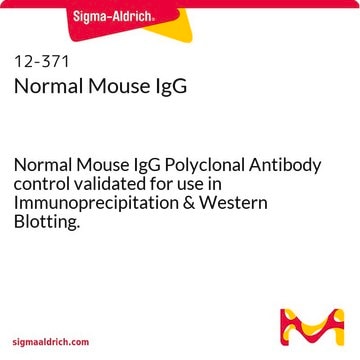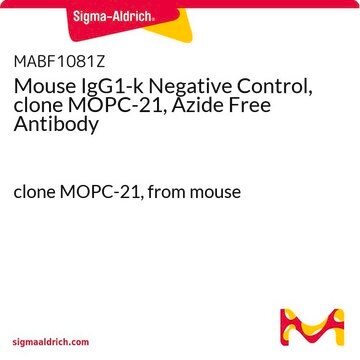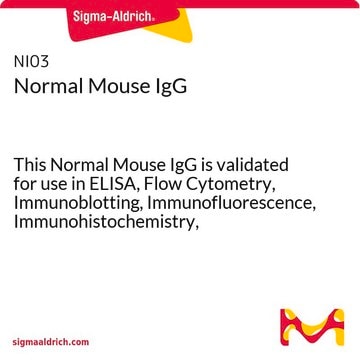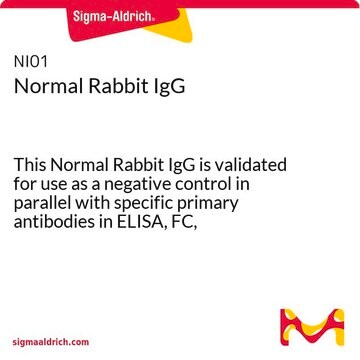推薦產品
生物源
mouse
品質等級
抗體表格
purified immunoglobulin
無性繁殖
Ci4, monoclonal
製造商/商標名
Chemicon®
濃度
0.5 mg/mL
技術
flow cytometry: suitable
immunofluorescence: suitable
同型
IgG1
運輸包裝
wet ice
目標翻譯後修改
unmodified
一般說明
Immunoglobulin G (IgG), is one of the most abundant proteins in human serum with normal levels between 8-17 mg/mL in adult blood. IgG is important for our defence against microorganisms and the molecules are produced by B lymphocytes as a part of our adaptive immune response. The IgG molecule has two separate functions; to bind to the pathogen that elicited the response and to recruit other cells and molecules to destroy the antigen. The variability of the IgG pool is generated by somatic recombination and the number of specificities in an individual at a given time point is estimated to be 1011 variants.
特異性
Reacts with chicken immunoglobulin. No reaction with human cell surface or plasma components has been observed. However some binding to Fc receptors may occur.
免疫原
Chicken immunoglobulin
應用
Mouse IgG1 Negative Control Monoclonal Antibody validated for use in Flow Cytometry & Immunofluorescence.
Mouse IgG1 is a monoclonal antibody intended for use as a negative control in immunofluorescence, flow cytometry, and immunoperoxidase staining on frozen and paraffin tissue sections. Its use enables an estimation of non-specific binding of mouse monoclonal antibodies to cell surface components in peripheral blood and tissue.
SUGGESTED USAGE
The control antibody should be diluted to the same concentration as the test antibody, and equivalent volumes used.
SUGGESTED USAGE
The control antibody should be diluted to the same concentration as the test antibody, and equivalent volumes used.
Research Category
Secondary & Control Antibodies
Epitope Tags & General Use
Secondary & Control Antibodies
Epitope Tags & General Use
Research Sub Category
Isotype Control Antibodies
Isotype Control Antibodies
外觀
Protein A purified
Format: Purified
Protein A Purified mouse immunoglobulin in phosphate buffered saline, pH 7.4, containing 0.2% bovine Serum albumin and 0.1% sodium azide.
儲存和穩定性
Maintain for 1 year at 2–8°C from date of shipment. For maximum recovery of product, centrifuge the original vial after thawing and prior to removing the cap.
法律資訊
CHEMICON is a registered trademark of Merck KGaA, Darmstadt, Germany
免責聲明
Unless otherwise stated in our catalog or other company documentation accompanying the product(s), our products are intended for research use only and are not to be used for any other purpose, which includes but is not limited to, unauthorized commercial uses, in vitro diagnostic uses, ex vivo or in vivo therapeutic uses or any type of consumption or application to humans or animals.
儲存類別代碼
12 - Non Combustible Liquids
水污染物質分類(WGK)
WGK 2
閃點(°F)
Not applicable
閃點(°C)
Not applicable
分析證明 (COA)
輸入產品批次/批號來搜索 分析證明 (COA)。在產品’s標籤上找到批次和批號,寫有 ‘Lot’或‘Batch’.。
客戶也查看了
Liku B Tezera et al.
eLife, 9 (2020-02-25)
Previously, we developed a 3-dimensional cell culture model of human tuberculosis (TB) and demonstrated its potential to interrogate the host-pathogen interaction (Tezera et al., 2017a). Here, we use the model to investigate mechanisms whereby immune checkpoint therapy for cancer paradoxically
Sandra Rizzi et al.
Biochemistry and biophysics reports, 4, 291-298 (2015-10-09)
The sodium-activated potassium channels Slick (Slo2.1, KCNT2) and Slack (Slo2.2, KCNT1) are paralogous channels of the Slo family of high-conductance potassium channels. Slick and Slack channels are widely distributed in the mammalian CNS and they play a role in slow
Lukas Amrell et al.
Cancer cell international, 24(1), 277-277 (2024-08-07)
Tucatinib (TUC), a HER2-directed tyrosine kinase inhibitor, is the first targeted drug demonstrating intracranial efficacy and significantly prolonged survival in metastatic HER2-positive breast cancer (BC) patients with brain metastases. Current treatments for brain metastases often include radiotherapy, but little is
E-cadherin and its downstream catenins are proteolytically cleaved in human HaCaT keratinocytes exposed to UVB.
Hung, Chi-Feng, et al.
Experimental Dermatology, 15, 315-321 (2006)
Differential distribution of the sodium-activated potassium channels slick and slack in mouse brain.
Sandra Rizzi et al.
The Journal of comparative neurology, 524(10), 2093-2116 (2015-11-21)
The sodium-activated potassium channels Slick (Slo2.1, KCNT2) and Slack (Slo2.2, KCNT1) are high-conductance potassium channels of the Slo family. In neurons, Slick and Slack channels are involved in the generation of slow afterhyperpolarization, in the regulation of firing patterns, and
Active Filters
我們的科學家團隊在所有研究領域都有豐富的經驗,包括生命科學、材料科學、化學合成、色譜、分析等.
聯絡技術服務












